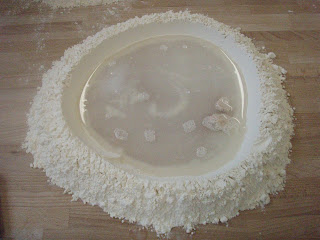Tonight, I was one of those people. Having just come out of the oven, the baguettes were so hot that they kept me warm the whole way home. In fact, I treasured them so much that when it began to rain I held them tight as if they were my newborn child, and I was in a war zone and not in the middle of the paradise called Paris.
You may be asking yourself why in the world I cared so much about these "run of the mill" baguettes that you can buy on almost every corner. Well, because I spent five hours making them, that's why! Today was our first Boulangerie class. It was so much fun to learn how to make bread the tradional way the French do. I also learned to respect bakers as it takes a lot of time, patience and finesse to make really outstanding bread.
Today, the Boulangerie Chef showed us how to make a Baguette Traditions, which is a handmade baguette. We also made several different specialty breads: whole wheat, rye, pain de mie, etc. I found that making the dough by hand was much more rewarding and fascinating than using a machine. However, if I were a baker and had to be up every morning at 4 am, I might change my tune and be thankful for all the technological advances in the recent past.
Needless to say, I enjoyed my fair share of bread this evening and can honestly say that I have never been prouder to walk down the streets of Paris than I was tonight with my hot, freshly baked, crusty bread. The aroma was intoxicating.
How to make baguette tradition:

Make the well (all too familiar by now).

Add water, salt and yeast.

Mix.

Until thick and pull together.

Knead for 20-25 minutes. Again, arm muscles are in high demand!

Flatten it and "turn" like puff pastry one time.

Let rest again (Wish I could rest as much as this dough does).

Roll by hand into baguettes. And guess what? Rest again (see what I mean?).

Bake in the coolest contraption to call itself an oven ever.

Finished product. How cute! Makes you want to grab a tub of butter, doesn't it? Don't lie.

An industiral baker's life saver. A machine that forms the baguette for you. Throw the bread in the top.

And it pops out shaped just like this. Don't ask me how. I feel like there has to be little dough elves in there to make it so perfect.

And the types of bread the different flours produce.













2 comments:
Bonjour,
Nous sommes dans la classe de francais IV de Mme Meehan a Loyola.
Combien de temps est-ce que la pate doit se reposer chaque fois?
Combien de levure, d'eau,de sel et de farine doit-on utiliser pour faire du pain? Nous aimons vos photos et vos commentaires.
Amities,
La Classe de Francais IV dans le sous-sol!
Bonjour tout le monde,
J'étais si heureuse d'avoir un message de la classe de français IV de Mme Meehan. Je suis désolée que ma réponse soit un peu en retard. Mon mari, (Félix) vient d'arriver en France ce weekend donc aujourd’hui c'est le premier jour que j'ai eu le temps de faire quoi qu'il soit!
Ci-dessous, vous trouverez mes réponses aux questions que vous avez posées:
1. La pâte doit se reposer environ trente minutes chaque fois. Alors, il faut avoir de la patience pour être un boulanger!
2. Quinze grammes de levure.
Vingt grammes de sel.
Six cent trente grammes d'eau.
Un kilogramme de farine.
Mme Meehan est le meilleur prof à Loyola. Écoutez-elle et faites ce qu'elle vous dit et vous apprendrez beaucoup! Bon chance!
Blanche
Post a Comment